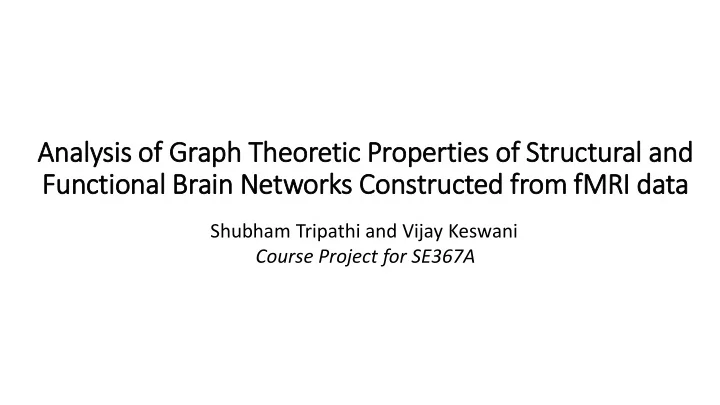

Analysis of f Graph Theoretic Properties of f Stru ructural and Functional Brain Networks Constructed fr from fM fMRI data Shubham Tripathi and Vijay Keswani Course Project for SE367A
Network Properties of the Brain ● Small-world network topology of the brain ● High information transfer efficiency at low wiring costs ● Highly connected hub regions ● Salvador R, et al (2006), Wang L, et al (2009) and many others have recently used large volume of fMRI data to prove that the brain has above network properties.
Small-World Topology ● Characteristic path length : Average of shortest paths b/w all pairs of nodes in the graph ● Clustering coefficient of a node : (Number of neighbours / total nodes); a popular measure of interconnectivity of a network ● A small-world network has short characteristic path length but high clustering coefficient.
Small-World Topology
BOLD fMRI • BOLD stands for Blood Oxygen Level Dependent. • This technique is based on monitoring the levels of oxygenated and deoxygenated blood in successive brain slices that are excited with a radio pulse in the presence of a strong magnetic field (0.3 tesla to 7 tesla). • The entire brain volume is mapped several times over a period of time, with each imaging cycle usually taking about 2 seconds (TR). • fMRI data file for a patient consists of activation levels at any point of time for about 1,00,000 brain voxels (3D cubical regions into which the brain is divided)
Hemodynamic Response Function
fMRI Datasets
BOLD fMRI Data Model
Functional Brain Connectivity • Principal Component Analysis or Independent Analysis can be utilized to extract functional brain connectivity information from fMRI data. • We then utilize this information to model the brain as a graph.
References • Martin A. Lindquist (2008). The Statistical Analysis of fMRI data. Statistical Science Vol. 23 No. 4 439-464. ● Salvador R, Suckling J, Coleman MR, et al. (2005]) Neurophysiological architecture of functional magnetic resonance images of human brain. ● Cole MW, Pathak S, Schneider W. (2010) Identifying the brain’s most globally connected regions. ● Van den Heuvel MP, Stam CJ, Kahn RS (2009) Efficiency of functional brain networks and intellectual performance. ● Supekar K, Menon V, Rubin D, et al (2008) Network analysis of intrinsic functional brain connectivity in Alzheimer’s disease.
Thank You!
Recommend
More recommend